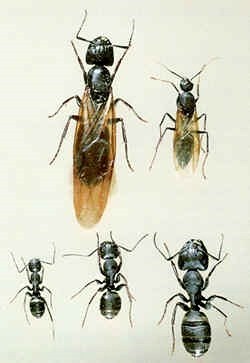Last updated: November 25, 2019
Article
Carpenter Ant

@ Laurel Hansen
General Description
Ants are some of the most successful and abundant land dwellers on the planet. With complex social organization that includes specialized castes, farming, and war, the ant family, Formicidae, in the order, Hymenoptera, comprises over 13,000 known (and more unknown) species that range throughout most terrestrial habitats. Entomologist, E.O. Wilson, once famously said, in reference to ants, “Karl Marx was right, socialism works; it is just that he had the wrong species.” One group within this family contains over 1000 species in the genus, Camponotus, collectively known as carpenter ants. And as their name implies, most species are tightly tied to wood.
Carpenter ants include the largest ants in North America, with workers reaching up to 12 mm (0.5 in) long for some species and queens up to 20 mm (~1 in). They have black or reddish bodies with the following ant family characteristics: 3 distinct body regions (head, and then thorax separated from abdomen by narrow waist), and antennae with a sharp bend. This bend is called “elbowed,” and is one way to distinguish them from termites, which have straight antennae. Common Western species, like Camponotus modoc, have long brownish-golden hairs on their abdomens. Carpenter ants differ in size, which also reflects the three different castes into which they are born. The largest is the queen, males are smaller, and the worker ants are sometimes further divided by size into majors, media, and minors (the smallest size).
Habitat
Carpenter ants typically nest in the dead or decaying wood of trees, stumps, logs, and dead branches, though some species nest in the soil. Unfortunately for us, they also nest in building material weakened by moisture. Yes, houses, sheds, and lumber piles can become targets. Colonies excavate tunnels and galleries in moist wood for one “parent” nest, but they may also have satellite nests. These satellite nests can exist in drier, sounder wood, since they contain only workers, pupae, and mature larvae; eggs need the moisture of the primary nest. While digging, they clean up as they go, pushing the resulting sawdust out of the nest. Indeed, piles of sawdust near a hole in the wood is one sign of carpenter ant infestation.
Diet and Behavior
Carpenter ants don’t actually eat the wood they excavate (unlike termites), lacking the digestive enzymes to break down cellulose. Instead, they forage on a wide variety of plant and animal materials, including sweet substances, like honeydew produced by aphids. They also eat the body fluids and proteins of both dead and live insects. Most of this foraging is at night, kept somewhat hidden by the underground tunnels they use. Carpenter ants have a painful bite, but cannot sting.
Reproduction
Like most ant species, carpenter ant colonies usually have one or a few queens that lay all the eggs. The reproductive cycle begins when a newly mated queen finds a new place to nest and lays several eggs. She tends this initial batch of eggs. Undergoing complete metamorphosis, the eggs hatch into legless larvae, which eventually pupate into adults with legs. These first adults of the colony are its workers, and all workers are sterile females. The workers gather food and care for the queen and growing young as she continues to lay eggs in the galleries that the workers excavate. In some species of carpenter ants, colonies may contain 50,000 ants or more! After a few years, an established colony will create its first reproductive males and females, which are winged (called “swarmers,” or “alates”). In spring, they leave the nest in a “nuptial swarm” to mate nearby. The fertile males die soon after and the mated females disperse to start their own new colony, eventually dropping their wings.
Fun facts
Hilltopping: When the winged swarmers emerge in spring to mate, they often gather at pronounced points on the landscape, like a large tree or lone building or top of a hill, thus the term, “hilltopping.” The swarms can turn into rolling clusters of males trying to mate with a single female.
Exploding ants: Some Malaysian carpenter ant species make the ultimate sacrifice to defend against attackers. They can explode their bodies, spraying a sticky and caustic fluid from inside a special jaw-to-abdomen-length gland, which immobilizes the enemy.
Where to See
Based on range maps, we expect carpenter ants to occupy all Klamath Network parks in southern Oregon and northern California.
Learn More
http://blogs.oregonstate.edu/mgmetro/2018/04/01/carpenter-ants/
https://bugguide.net/node/view/354
Download a pdf of this article.
Prepared by Sonya Daw
NPS Klamath Inventory & Monitoring Network
Southern Oregon University
1250 Siskiyou Blvd
Ashland, OR 97520
Featured Creature Edition: November 2019
